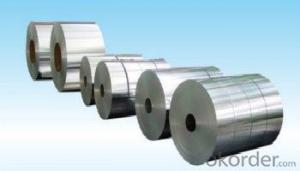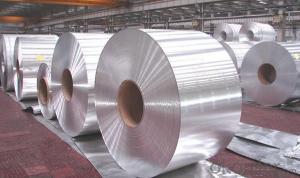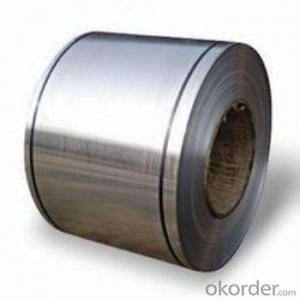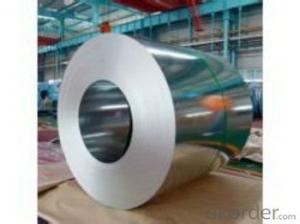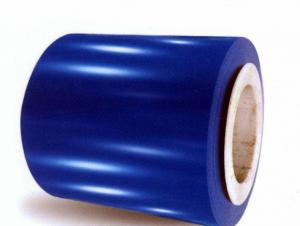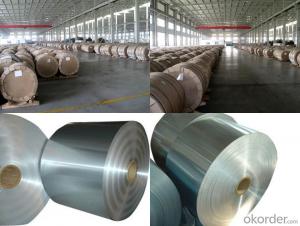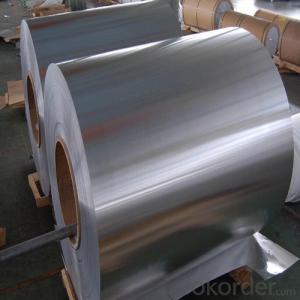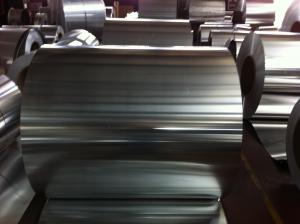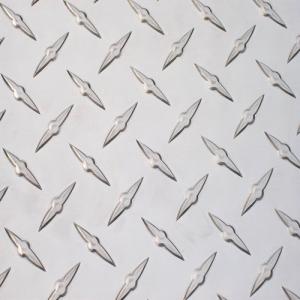Petersen Aluminum Coil - Mill Finished Aluminum Coil AA3003 Temper H14
- Loading Port:
- Shanghai
- Payment Terms:
- TT or LC
- Min Order Qty:
- 10 m.t.
- Supply Capability:
- 4000 m.t./month
OKorder Service Pledge
OKorder Financial Service
You Might Also Like
Specification
1. Aluminum Coil Description:
Aluminum coil, is a rolled product, produced in a coiled form of continuous strip, and having an ID (Inner diameter) and OD (Outer diameter).Common alloy coil are used for a wide variety of applications, alloy 1050, 1060, 3003, 3105, 3005, 5052, 5754, 5083, 6061, 8011, 8021, and so on, in thickness from 0.0065-7mm, in width from 300- 2200mm.
Aluminium coil can be deep processed into aluminium foilstock, aluminium circle, aluminium coating products, aluminium ceiling, aluminium plastic composite panel (APCP), aluminium embossed products, etc.
2.Main Features of the Aluminum Coil:
• Great ductility
• Heat conductivity
• Anti-corrosion
• Moisture resistanve
3.Aluminum Coil Images
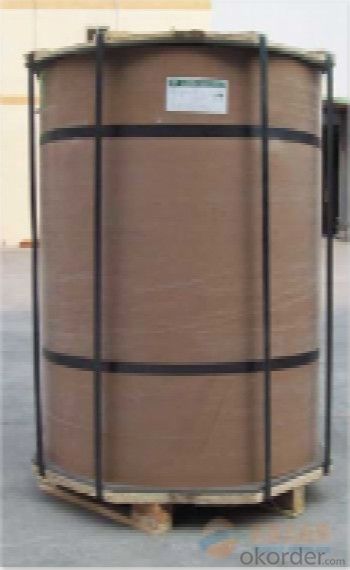
4.Aluminum Coil Specification
Aluminum Coil/Sheet | |
Main Specification | |
Alloy | AA1xxx (AA1050, AA1060, AA1070, AA1100 etc.) |
AA3xxx (AA3003, AA3004, AA3005, AA3105 etc.) | |
AA5xxx, AA6XXX (AA5052,AA5083, AA5754, AA6061, AA6062 etc.) | |
AA8xxx(AA8011, AA8006, AA8079 etc.) | |
Temper | H14,H16, H18, H22, H24, H26, H32,O/F |
Thickmess | ≥0.2mm |
Width | 30mm-2100mm |
Standard | GB/T 3880-2006 |
Special specification is available on customer's requirement | |
5.FAQ
We have organized several common questions for our clients,may help you sincerely:
(1) How to guarantee the quality of the products?
We have established the international advanced quality management system, every link from raw material to final product. we have strict quality test; we resolutely put an end to unqualified products flowing into the market. At the same time, we will provide necessary follow-up service assurance.
(2) MOQ?
For trail order, we accept 10 MT.
(3) Payment term?
30% deposit, balance against the BL copy; 100% L/C at sight
(4) What is the delivery time?
Depends on actual order, around 30 to 35 days
- Q: How are aluminum coils used in the production of automotive radiators?
- Aluminum coils are used in the production of automotive radiators as they provide excellent heat transfer properties. These coils are typically made from aluminum alloy, which is lightweight, corrosion-resistant, and has high thermal conductivity. The coils are formed into a specific shape and then attached to the radiator's core. As coolant flows through the coils, heat from the engine is transferred to the aluminum, which efficiently dissipates it. This helps in cooling the engine and maintaining its optimal operating temperature. Overall, aluminum coils play a crucial role in enhancing the efficiency and performance of automotive radiators.
- Q: Is there any specific regulation or standard that dictates the weight of an aluminum coil?
- <p>Yes, there are regulations and standards that dictate the weight of aluminum coils. These are often set by industry standards such as ASTM (American Society for Testing and Materials) and EN (European Norm). The weight of an aluminum coil can vary depending on its thickness, width, and length, and manufacturers must adhere to these standards to ensure consistency and quality. For example, ASTM B 209 specifies the standard for aluminum and aluminum alloy sheet and plate, which includes weight limits. Compliance with these standards is crucial for the safety and performance of products that utilize aluminum coils.</p>
- Q: Can aluminum coils be used in the production of cryogenic storage tanks?
- Yes, aluminum coils can be used in the production of cryogenic storage tanks. Aluminum is a suitable material for cryogenic applications due to its low density, high thermal conductivity, and excellent corrosion resistance. These properties make it ideal for storing and transporting cryogenic liquids such as liquid nitrogen, oxygen, and argon. Aluminum coils can be used to fabricate the inner shell of the storage tank, providing a lightweight and durable solution. Additionally, aluminum is easily formable, allowing for the creation of complex tank shapes and designs. However, it is important to note that aluminum has a higher coefficient of thermal expansion compared to other materials like stainless steel, so proper design considerations must be taken to accommodate for thermal contraction and expansion during cryogenic operations.
- Q: What are the standard widths of aluminum coils?
- The specific industry and application play a role in determining the varying standard widths of aluminum coils. Generally, aluminum coils come in widths ranging from 12 inches (30.48 cm) to 60 inches (152.4 cm). These widely accepted widths are commonly utilized in construction, transportation, and manufacturing sectors. It is worth mentioning that customized widths are also readily accessible to meet specific project needs in the market.
- Q: Are aluminum coils suitable for electrical conductors?
- Yes, aluminum coils are suitable for electrical conductors. Aluminum is a widely used material in the electrical industry due to its excellent electrical conductivity. It has around 61% conductivity of copper, which is the most commonly used metal for electrical conductors. Aluminum coils are lightweight, cost-effective, and have good thermal conductivity, making them a popular choice for various electrical applications. However, it is important to note that aluminum has a lower tensile strength compared to copper, so it may require a larger cross-sectional area to achieve the same level of current carrying capacity. Additionally, proper insulation and connectors are necessary to prevent oxidation and ensure efficient electrical conductivity in aluminum coils.
- Q: What are the common surface defects or issues in aluminum coils?
- Aluminum coils may exhibit various surface defects or issues that can arise from different causes. These defects can have detrimental effects on the appearance, quality, and functionality of the coils. Therefore, it is crucial for manufacturers and users to be mindful of these defects and implement necessary measures to prevent or reduce their occurrence. Scratches, for instance, are visible marks on the coil surface that result from contact with abrasive materials or mishandling during production, transportation, or storage. Streaks, on the other hand, manifest as long, narrow lines or bands on the coil surface, often caused by irregularities in the rolling process or impurities present in the aluminum material. Dents are localized depressions or deformations that can occur due to mishandling, accidental impacts, or improper storage practices. Corrosion, though aluminum is generally resistant, can arise from specific environmental conditions or exposure to corrosive agents, leading to the formation of oxide layers or pitting on the coil surface. Edge cracks refer to fissures that appear along the coil edges, resulting from improper cutting or shearing during manufacturing. Surface roughness, characterized by an uneven or bumpy texture, can arise from inadequate smoothing or finishing during rolling or processing. Oil stains may be observed as dark or discolored areas on the coil surface, caused by improper cleaning or lubrication during production. Coil set refers to the coil's tendency to retain a curvature or shape after unwinding, resulting from stresses induced during rolling, coiling, or cooling, leading to an uneven and non-flat surface. Roll marks are patterns or imprints left on the coil surface by the rolling mill or equipment, caused by uneven pressure or improper tool alignment. Discoloration, characterized by changes in color or appearance, can result from exposure to high temperatures, chemical reactions, or oxidation. It is essential to recognize these surface defects and their potential impact on the quality and performance of aluminum coils. By taking appropriate preventive measures, manufacturers and users can minimize these defects and ensure the desired appearance and functionality of the coils.
- Q: What are the different types of protective coatings for aluminum coils?
- Aluminum coils can benefit from various protective coatings to boost their durability and lifespan while safeguarding against environmental elements. 1. Polyester Coatings: With their exceptional UV ray and weather resistance, polyester coatings are widely utilized for aluminum coils. They offer vibrant color retention and a broad spectrum of color options, making them ideal for applications where aesthetics matter, such as in architecture. 2. Polyvinylidene Fluoride (PVDF) Coatings: Renowned for their exceptional resistance against fading, chalking, and chemical exposure, PVDF coatings are suitable for harsh environments. They exhibit high weatherability and can withstand extreme temperatures, making them commonly used in industrial and commercial settings. 3. Epoxy Coatings: Epoxy coatings present robust adhesion and excellent corrosion resistance. They act as a protective barrier against moisture and chemicals, making them well-suited for applications where the coils may encounter harsh conditions, particularly in marine and industrial settings. 4. Acrylic Coatings: Acrylic coatings offer good adhesion and flexibility. They provide moderate weather resistance and can be easily applied and repaired. Acrylic coatings find applications in various sectors, including automotive and general industrial uses. 5. Polyurethane Coatings: Polyurethane coatings showcase outstanding resistance to abrasion, chemicals, and weathering. They offer exceptional durability and are commonly employed in demanding applications where the coils may face harsh conditions or heavy wear. 6. Silicone Coatings: Silicone coatings boast remarkable resistance to extreme temperatures and UV exposure. They exhibit excellent weatherability and can endure prolonged exposure to sunlight without degradation. Silicone coatings are frequently utilized in automotive parts and outdoor equipment. The selection of the appropriate protective coating should be based on the specific requirements of the aluminum coils and the intended application. Factors to consider include the desired level of protection, appearance, and the environmental conditions to which the coils will be exposed.
- Q: How do aluminum coils contribute to the aesthetics of architectural designs?
- Architectural designs are significantly enhanced by the inclusion of aluminum coils, which offer a multitude of benefits. Firstly, their versatility in terms of shape and size is a key factor. This adaptability allows for the easy formation of aluminum coils into diverse shapes, making them suitable for a wide array of architectural applications. Moreover, the lightweight nature of aluminum coils contributes to their aesthetic appeal. When used in cladding or façade systems, they provide buildings with a sleek and modern appearance. This, in turn, adds a touch of elegance to the overall design, resulting in visually pleasing structures. Furthermore, aluminum coils offer a broad range of color options. Their coatability and ability to be painted provide architects and designers with an extensive palette of colors to choose from. This vast selection allows for the matching of a building's exterior with its surroundings or the creation of a specific mood or theme. The availability of various colors for aluminum coils opens up endless possibilities for customization and creativity in architectural design. Additionally, the durability and corrosion resistance of aluminum coils make them ideal for long-lasting architectural applications. They can withstand harsh weather conditions, ensuring that the building's aesthetics remain intact over time. This durability factor is crucial in maintaining the visual appeal of architectural designs, as it eliminates the need for frequent repairs or replacements. In conclusion, aluminum coils significantly contribute to the aesthetics of architectural designs due to their versatility, lightweight nature, color options, and durability. Their ability to be shaped into various forms, combined with a wide range of color choices, allows architects and designers to create visually stunning and customized buildings. The sleek and modern appearance of aluminum coils adds a touch of elegance to architectural designs, enhancing their overall aesthetics.
- Q: What are the common cleaning and maintenance products for aluminum coils?
- Aluminum coils can be cleaned and maintained using various products. One popular option is a mild detergent mixed with water. This mixture can be applied to the coils using a soft brush or cloth, and then rinsed off with water. Another commonly used product is a coil cleaner specifically designed for aluminum surfaces. These cleaners are usually available in spray or foam form and effectively remove dirt, grease, and oxidation from the coils. It is important to carefully follow the manufacturer's instructions when using these cleaners. Additionally, a mixture of white vinegar and water can be used to clean aluminum coils. This natural cleaning solution effectively removes mineral deposits and stains. It can be applied with a cloth or sponge and then rinsed off with water. Regular maintenance of aluminum coils also includes using a coil coating or sealant. These products create a protective layer on the coils, preventing corrosion and extending their lifespan. It is advisable to apply the coating or sealant according to the manufacturer's instructions. When cleaning and maintaining aluminum coils, it is crucial to avoid using abrasive cleaners, bleach, or harsh chemicals as they can damage the coils. If uncertain about the appropriate cleaning and maintenance products for specific aluminum coils, it is recommended to consult the manufacturer's guidelines or seek professional advice.
- Q: Is it possible to use aluminum coils in the creation of toys or games for children?
- <p>Yes, aluminum coils can be used to make toys or games for children, but safety considerations must be taken into account. Aluminum is a lightweight, durable, and non-toxic material, making it suitable for various applications, including children's toys. However, it's crucial to ensure that any aluminum used in toys is properly treated to prevent sharp edges or small parts that could pose a choking hazard. Additionally, the toys or games should be designed and manufactured to meet safety standards and regulations to protect children from potential harm.</p>
Send your message to us
Petersen Aluminum Coil - Mill Finished Aluminum Coil AA3003 Temper H14
- Loading Port:
- Shanghai
- Payment Terms:
- TT or LC
- Min Order Qty:
- 10 m.t.
- Supply Capability:
- 4000 m.t./month
OKorder Service Pledge
OKorder Financial Service
Similar products
Hot products
Hot Searches
Related keywords













